Analysis of Business Communication Strategies: Tesco Company Report
VerifiedAdded on 2019/12/28
|12
|3434
|165
Report
AI Summary
This report provides a comprehensive analysis of business communication strategies employed by Tesco. It begins by examining different types of business information, including written and verbal communication, their sources, and purposes, focusing on how Tesco utilizes these for internal and external operations. The report then delves into the presentation of complex internal business information, showcasing various methods like presentations, reports, and leaflets, tailored to specific user needs. Furthermore, it analyzes Tesco's corporate communication efforts, evaluating the effectiveness of their communication strategies as key contributors to the organization's success. The report also addresses the legal and ethical issues surrounding the use of business information, such as the Data Protection Act and the Freedom of Information Act, and concludes with an overview of operational issues related to information management within the company.
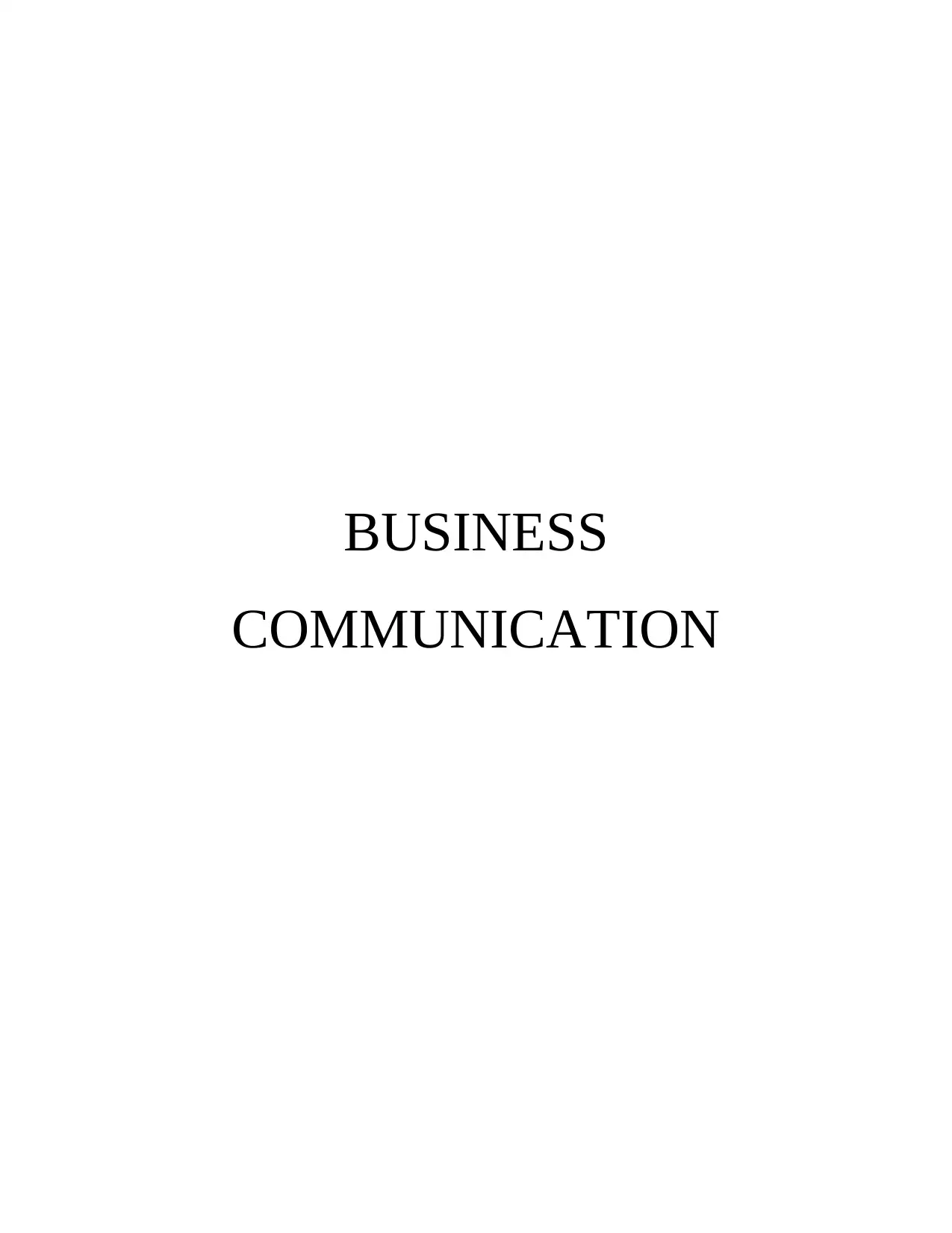
BUSINESS
COMMUNICATION
COMMUNICATION
Paraphrase This Document
Need a fresh take? Get an instant paraphrase of this document with our AI Paraphraser
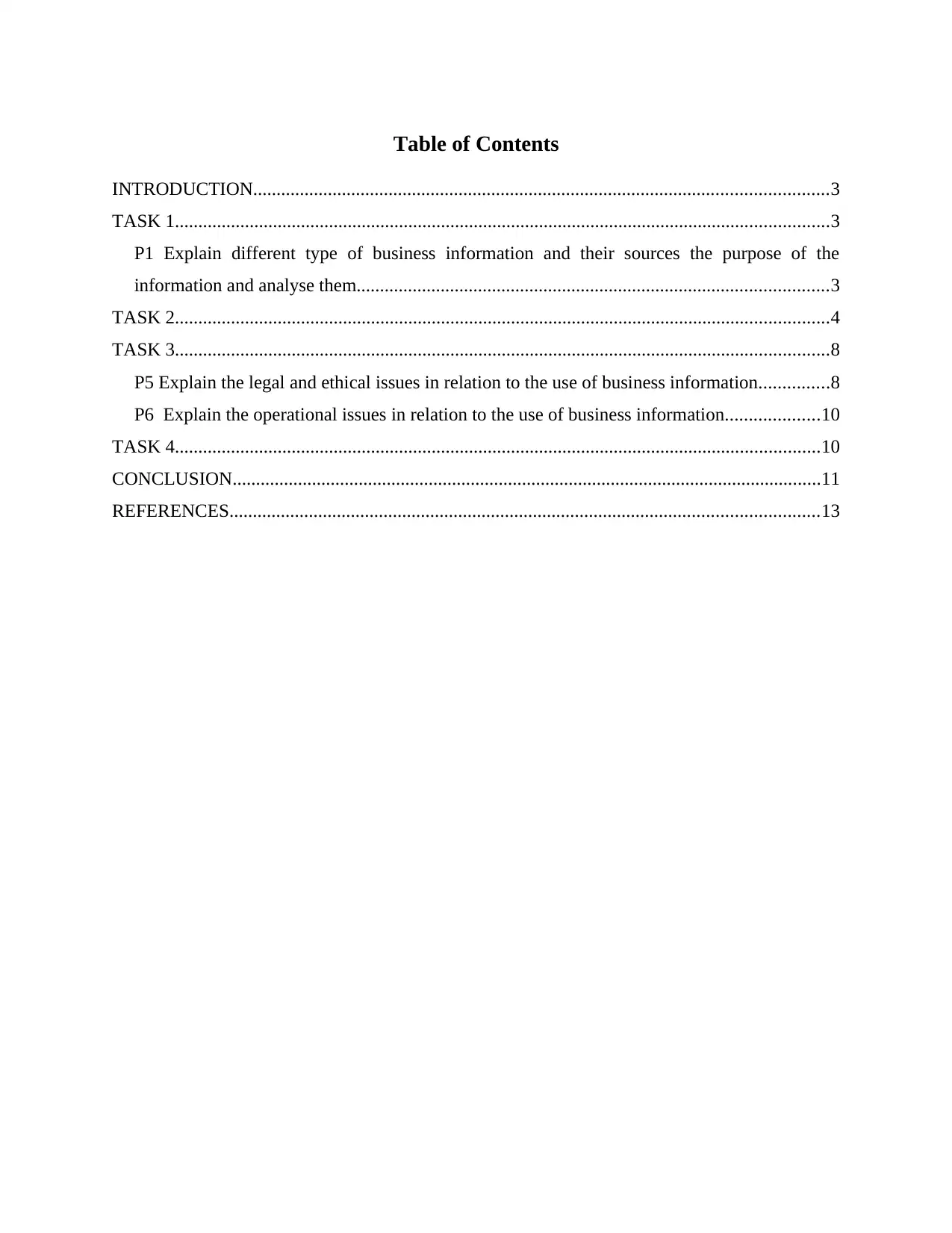
Table of Contents
INTRODUCTION...........................................................................................................................3
TASK 1............................................................................................................................................3
P1 Explain different type of business information and their sources the purpose of the
information and analyse them.....................................................................................................3
TASK 2............................................................................................................................................4
TASK 3............................................................................................................................................8
P5 Explain the legal and ethical issues in relation to the use of business information...............8
P6 Explain the operational issues in relation to the use of business information....................10
TASK 4..........................................................................................................................................10
CONCLUSION..............................................................................................................................11
REFERENCES..............................................................................................................................13
INTRODUCTION...........................................................................................................................3
TASK 1............................................................................................................................................3
P1 Explain different type of business information and their sources the purpose of the
information and analyse them.....................................................................................................3
TASK 2............................................................................................................................................4
TASK 3............................................................................................................................................8
P5 Explain the legal and ethical issues in relation to the use of business information...............8
P6 Explain the operational issues in relation to the use of business information....................10
TASK 4..........................................................................................................................................10
CONCLUSION..............................................................................................................................11
REFERENCES..............................................................................................................................13
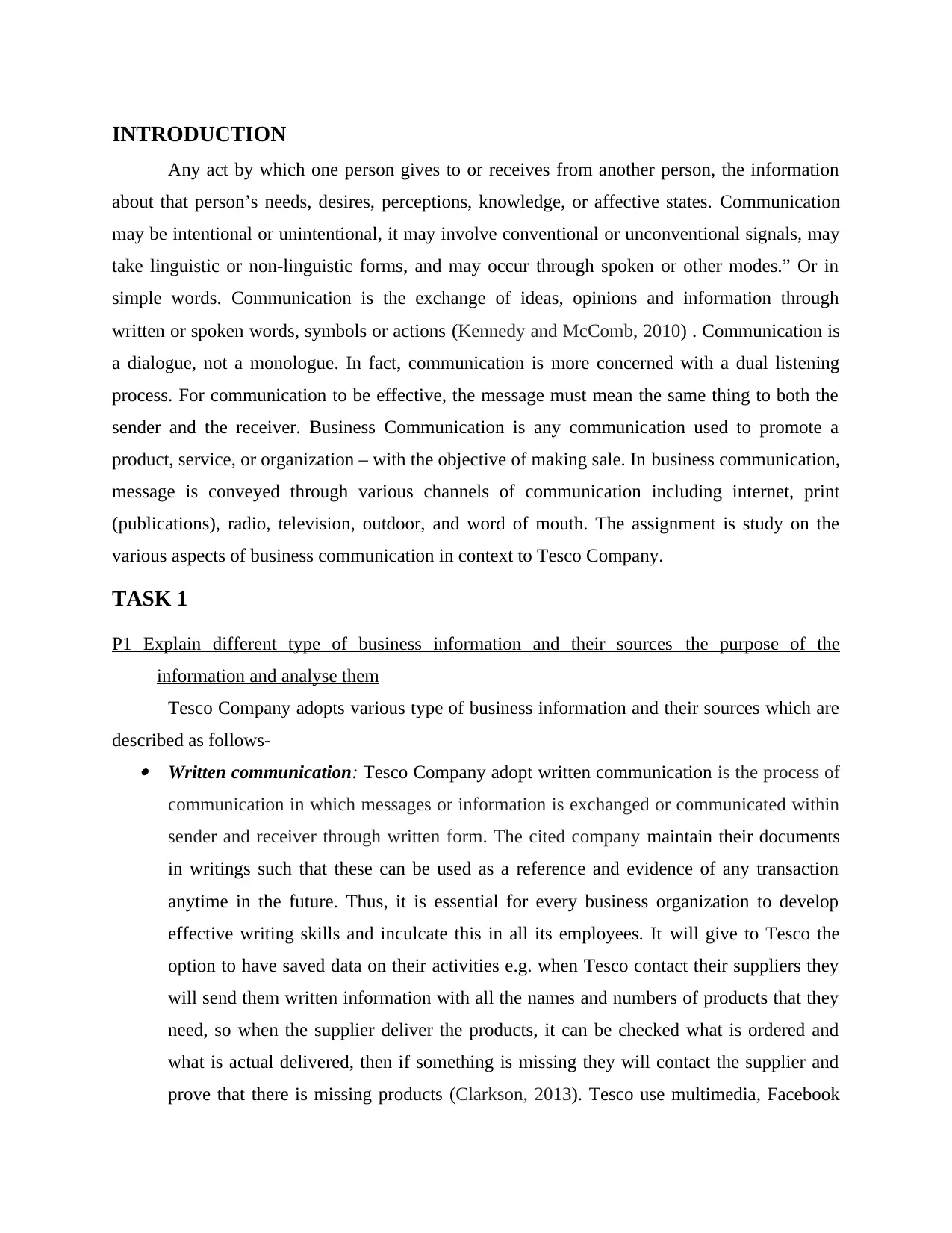
INTRODUCTION
Any act by which one person gives to or receives from another person, the information
about that person’s needs, desires, perceptions, knowledge, or affective states. Communication
may be intentional or unintentional, it may involve conventional or unconventional signals, may
take linguistic or non-linguistic forms, and may occur through spoken or other modes.” Or in
simple words. Communication is the exchange of ideas, opinions and information through
written or spoken words, symbols or actions (Kennedy and McComb, 2010) . Communication is
a dialogue, not a monologue. In fact, communication is more concerned with a dual listening
process. For communication to be effective, the message must mean the same thing to both the
sender and the receiver. Business Communication is any communication used to promote a
product, service, or organization – with the objective of making sale. In business communication,
message is conveyed through various channels of communication including internet, print
(publications), radio, television, outdoor, and word of mouth. The assignment is study on the
various aspects of business communication in context to Tesco Company.
TASK 1
P1 Explain different type of business information and their sources the purpose of the
information and analyse them
Tesco Company adopts various type of business information and their sources which are
described as follows- Written communication: Tesco Company adopt written communication is the process of
communication in which messages or information is exchanged or communicated within
sender and receiver through written form. The cited company maintain their documents
in writings such that these can be used as a reference and evidence of any transaction
anytime in the future. Thus, it is essential for every business organization to develop
effective writing skills and inculcate this in all its employees. It will give to Tesco the
option to have saved data on their activities e.g. when Tesco contact their suppliers they
will send them written information with all the names and numbers of products that they
need, so when the supplier deliver the products, it can be checked what is ordered and
what is actual delivered, then if something is missing they will contact the supplier and
prove that there is missing products (Clarkson, 2013). Tesco use multimedia, Facebook
Any act by which one person gives to or receives from another person, the information
about that person’s needs, desires, perceptions, knowledge, or affective states. Communication
may be intentional or unintentional, it may involve conventional or unconventional signals, may
take linguistic or non-linguistic forms, and may occur through spoken or other modes.” Or in
simple words. Communication is the exchange of ideas, opinions and information through
written or spoken words, symbols or actions (Kennedy and McComb, 2010) . Communication is
a dialogue, not a monologue. In fact, communication is more concerned with a dual listening
process. For communication to be effective, the message must mean the same thing to both the
sender and the receiver. Business Communication is any communication used to promote a
product, service, or organization – with the objective of making sale. In business communication,
message is conveyed through various channels of communication including internet, print
(publications), radio, television, outdoor, and word of mouth. The assignment is study on the
various aspects of business communication in context to Tesco Company.
TASK 1
P1 Explain different type of business information and their sources the purpose of the
information and analyse them
Tesco Company adopts various type of business information and their sources which are
described as follows- Written communication: Tesco Company adopt written communication is the process of
communication in which messages or information is exchanged or communicated within
sender and receiver through written form. The cited company maintain their documents
in writings such that these can be used as a reference and evidence of any transaction
anytime in the future. Thus, it is essential for every business organization to develop
effective writing skills and inculcate this in all its employees. It will give to Tesco the
option to have saved data on their activities e.g. when Tesco contact their suppliers they
will send them written information with all the names and numbers of products that they
need, so when the supplier deliver the products, it can be checked what is ordered and
what is actual delivered, then if something is missing they will contact the supplier and
prove that there is missing products (Clarkson, 2013). Tesco use multimedia, Facebook
⊘ This is a preview!⊘
Do you want full access?
Subscribe today to unlock all pages.

Trusted by 1+ million students worldwide
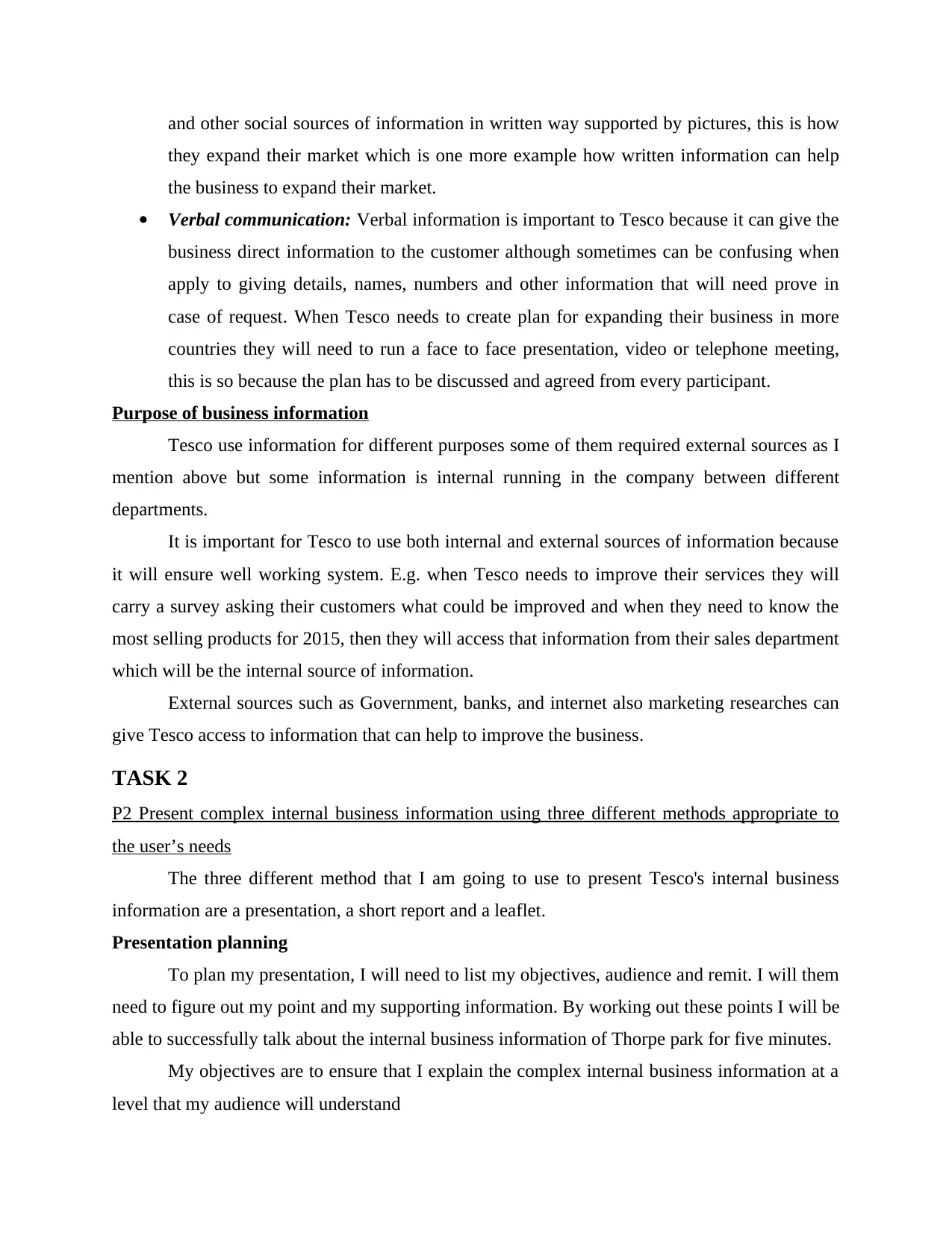
and other social sources of information in written way supported by pictures, this is how
they expand their market which is one more example how written information can help
the business to expand their market.
Verbal communication: Verbal information is important to Tesco because it can give the
business direct information to the customer although sometimes can be confusing when
apply to giving details, names, numbers and other information that will need prove in
case of request. When Tesco needs to create plan for expanding their business in more
countries they will need to run a face to face presentation, video or telephone meeting,
this is so because the plan has to be discussed and agreed from every participant.
Purpose of business information
Tesco use information for different purposes some of them required external sources as I
mention above but some information is internal running in the company between different
departments.
It is important for Tesco to use both internal and external sources of information because
it will ensure well working system. E.g. when Tesco needs to improve their services they will
carry a survey asking their customers what could be improved and when they need to know the
most selling products for 2015, then they will access that information from their sales department
which will be the internal source of information.
External sources such as Government, banks, and internet also marketing researches can
give Tesco access to information that can help to improve the business.
TASK 2
P2 Present complex internal business information using three different methods appropriate to
the user’s needs
The three different method that I am going to use to present Tesco's internal business
information are a presentation, a short report and a leaflet.
Presentation planning
To plan my presentation, I will need to list my objectives, audience and remit. I will them
need to figure out my point and my supporting information. By working out these points I will be
able to successfully talk about the internal business information of Thorpe park for five minutes.
My objectives are to ensure that I explain the complex internal business information at a
level that my audience will understand
they expand their market which is one more example how written information can help
the business to expand their market.
Verbal communication: Verbal information is important to Tesco because it can give the
business direct information to the customer although sometimes can be confusing when
apply to giving details, names, numbers and other information that will need prove in
case of request. When Tesco needs to create plan for expanding their business in more
countries they will need to run a face to face presentation, video or telephone meeting,
this is so because the plan has to be discussed and agreed from every participant.
Purpose of business information
Tesco use information for different purposes some of them required external sources as I
mention above but some information is internal running in the company between different
departments.
It is important for Tesco to use both internal and external sources of information because
it will ensure well working system. E.g. when Tesco needs to improve their services they will
carry a survey asking their customers what could be improved and when they need to know the
most selling products for 2015, then they will access that information from their sales department
which will be the internal source of information.
External sources such as Government, banks, and internet also marketing researches can
give Tesco access to information that can help to improve the business.
TASK 2
P2 Present complex internal business information using three different methods appropriate to
the user’s needs
The three different method that I am going to use to present Tesco's internal business
information are a presentation, a short report and a leaflet.
Presentation planning
To plan my presentation, I will need to list my objectives, audience and remit. I will them
need to figure out my point and my supporting information. By working out these points I will be
able to successfully talk about the internal business information of Thorpe park for five minutes.
My objectives are to ensure that I explain the complex internal business information at a
level that my audience will understand
Paraphrase This Document
Need a fresh take? Get an instant paraphrase of this document with our AI Paraphraser
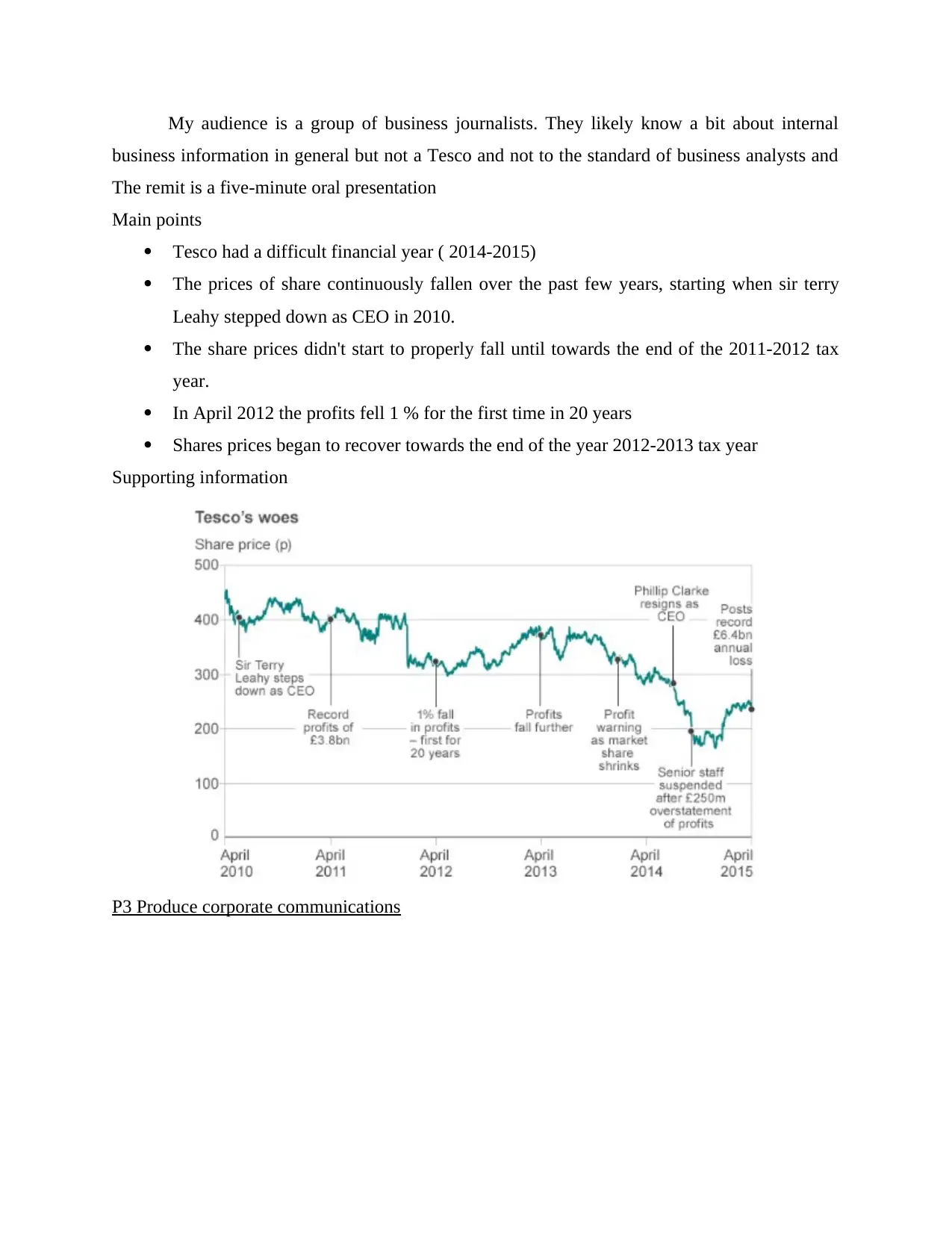
My audience is a group of business journalists. They likely know a bit about internal
business information in general but not a Tesco and not to the standard of business analysts and
The remit is a five-minute oral presentation
Main points
Tesco had a difficult financial year ( 2014-2015)
The prices of share continuously fallen over the past few years, starting when sir terry
Leahy stepped down as CEO in 2010.
The share prices didn't start to properly fall until towards the end of the 2011-2012 tax
year.
In April 2012 the profits fell 1 % for the first time in 20 years
Shares prices began to recover towards the end of the year 2012-2013 tax year
Supporting information
P3 Produce corporate communications
business information in general but not a Tesco and not to the standard of business analysts and
The remit is a five-minute oral presentation
Main points
Tesco had a difficult financial year ( 2014-2015)
The prices of share continuously fallen over the past few years, starting when sir terry
Leahy stepped down as CEO in 2010.
The share prices didn't start to properly fall until towards the end of the 2011-2012 tax
year.
In April 2012 the profits fell 1 % for the first time in 20 years
Shares prices began to recover towards the end of the year 2012-2013 tax year
Supporting information
P3 Produce corporate communications
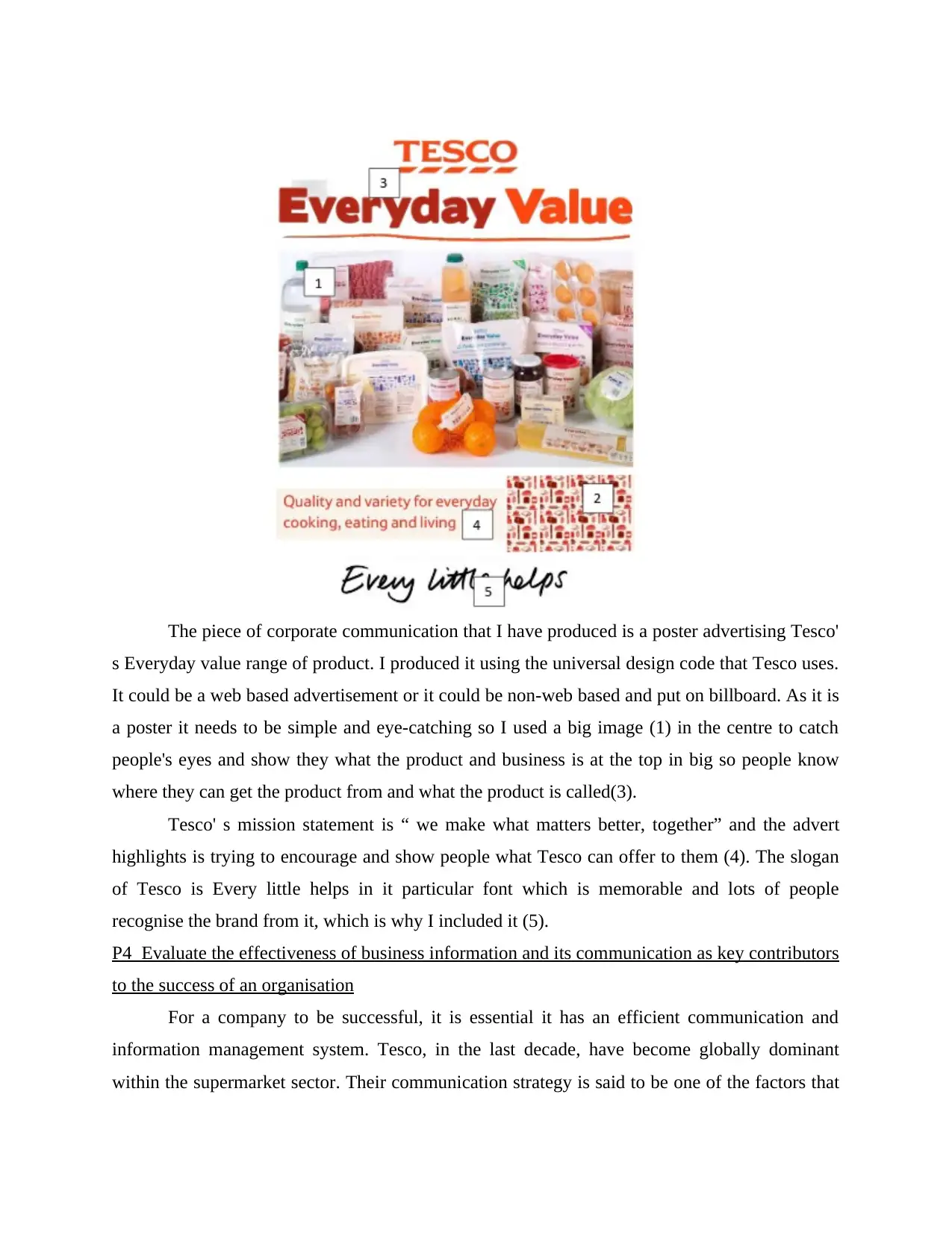
The piece of corporate communication that I have produced is a poster advertising Tesco'
s Everyday value range of product. I produced it using the universal design code that Tesco uses.
It could be a web based advertisement or it could be non-web based and put on billboard. As it is
a poster it needs to be simple and eye-catching so I used a big image (1) in the centre to catch
people's eyes and show they what the product and business is at the top in big so people know
where they can get the product from and what the product is called(3).
Tesco' s mission statement is “ we make what matters better, together” and the advert
highlights is trying to encourage and show people what Tesco can offer to them (4). The slogan
of Tesco is Every little helps in it particular font which is memorable and lots of people
recognise the brand from it, which is why I included it (5).
P4 Evaluate the effectiveness of business information and its communication as key contributors
to the success of an organisation
For a company to be successful, it is essential it has an efficient communication and
information management system. Tesco, in the last decade, have become globally dominant
within the supermarket sector. Their communication strategy is said to be one of the factors that
s Everyday value range of product. I produced it using the universal design code that Tesco uses.
It could be a web based advertisement or it could be non-web based and put on billboard. As it is
a poster it needs to be simple and eye-catching so I used a big image (1) in the centre to catch
people's eyes and show they what the product and business is at the top in big so people know
where they can get the product from and what the product is called(3).
Tesco' s mission statement is “ we make what matters better, together” and the advert
highlights is trying to encourage and show people what Tesco can offer to them (4). The slogan
of Tesco is Every little helps in it particular font which is memorable and lots of people
recognise the brand from it, which is why I included it (5).
P4 Evaluate the effectiveness of business information and its communication as key contributors
to the success of an organisation
For a company to be successful, it is essential it has an efficient communication and
information management system. Tesco, in the last decade, have become globally dominant
within the supermarket sector. Their communication strategy is said to be one of the factors that
⊘ This is a preview!⊘
Do you want full access?
Subscribe today to unlock all pages.

Trusted by 1+ million students worldwide
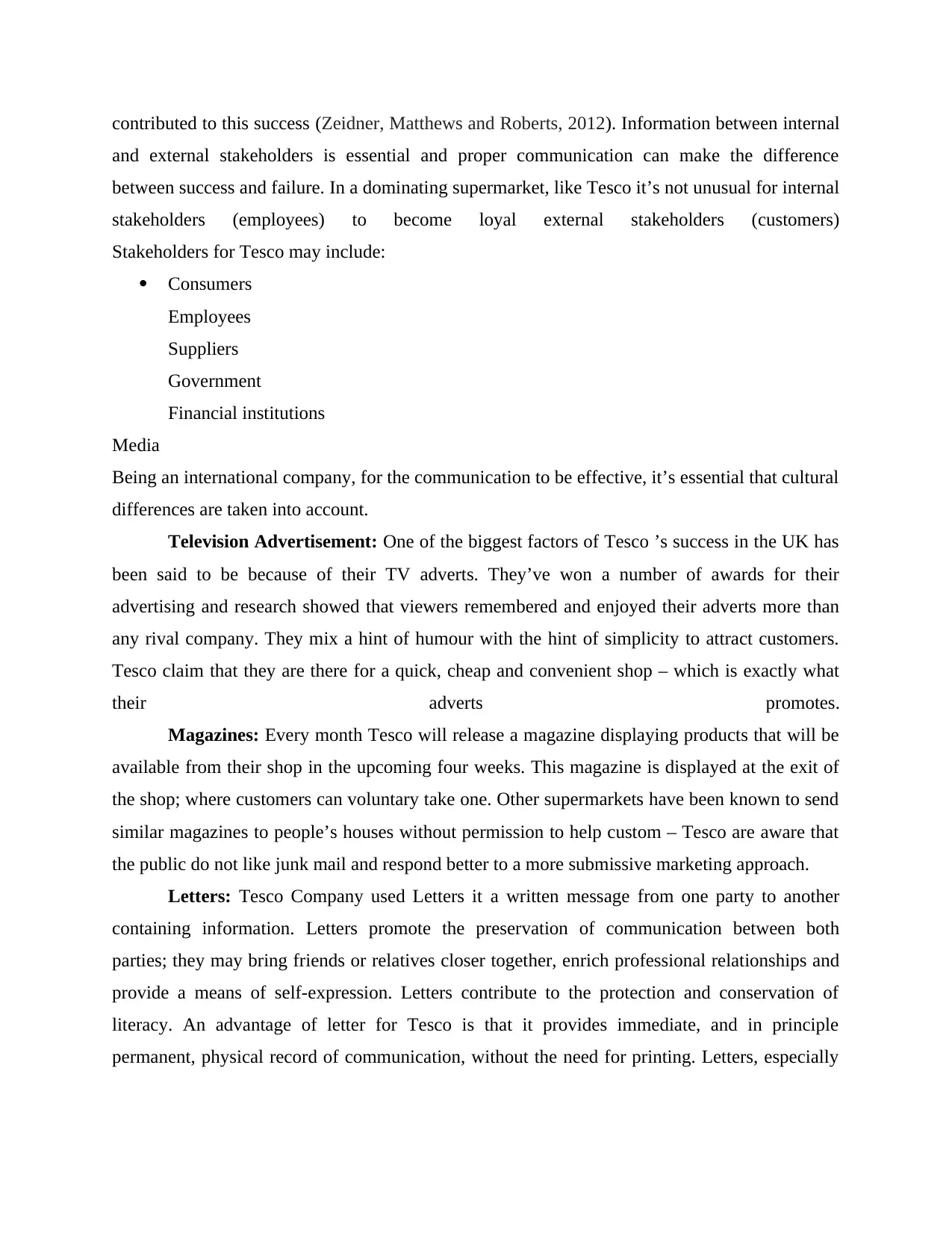
contributed to this success (Zeidner, Matthews and Roberts, 2012). Information between internal
and external stakeholders is essential and proper communication can make the difference
between success and failure. In a dominating supermarket, like Tesco it’s not unusual for internal
stakeholders (employees) to become loyal external stakeholders (customers)
Stakeholders for Tesco may include:
Consumers
Employees
Suppliers
Government
Financial institutions
Media
Being an international company, for the communication to be effective, it’s essential that cultural
differences are taken into account.
Television Advertisement: One of the biggest factors of Tesco ’s success in the UK has
been said to be because of their TV adverts. They’ve won a number of awards for their
advertising and research showed that viewers remembered and enjoyed their adverts more than
any rival company. They mix a hint of humour with the hint of simplicity to attract customers.
Tesco claim that they are there for a quick, cheap and convenient shop – which is exactly what
their adverts promotes.
Magazines: Every month Tesco will release a magazine displaying products that will be
available from their shop in the upcoming four weeks. This magazine is displayed at the exit of
the shop; where customers can voluntary take one. Other supermarkets have been known to send
similar magazines to people’s houses without permission to help custom – Tesco are aware that
the public do not like junk mail and respond better to a more submissive marketing approach.
Letters: Tesco Company used Letters it a written message from one party to another
containing information. Letters promote the preservation of communication between both
parties; they may bring friends or relatives closer together, enrich professional relationships and
provide a means of self-expression. Letters contribute to the protection and conservation of
literacy. An advantage of letter for Tesco is that it provides immediate, and in principle
permanent, physical record of communication, without the need for printing. Letters, especially
and external stakeholders is essential and proper communication can make the difference
between success and failure. In a dominating supermarket, like Tesco it’s not unusual for internal
stakeholders (employees) to become loyal external stakeholders (customers)
Stakeholders for Tesco may include:
Consumers
Employees
Suppliers
Government
Financial institutions
Media
Being an international company, for the communication to be effective, it’s essential that cultural
differences are taken into account.
Television Advertisement: One of the biggest factors of Tesco ’s success in the UK has
been said to be because of their TV adverts. They’ve won a number of awards for their
advertising and research showed that viewers remembered and enjoyed their adverts more than
any rival company. They mix a hint of humour with the hint of simplicity to attract customers.
Tesco claim that they are there for a quick, cheap and convenient shop – which is exactly what
their adverts promotes.
Magazines: Every month Tesco will release a magazine displaying products that will be
available from their shop in the upcoming four weeks. This magazine is displayed at the exit of
the shop; where customers can voluntary take one. Other supermarkets have been known to send
similar magazines to people’s houses without permission to help custom – Tesco are aware that
the public do not like junk mail and respond better to a more submissive marketing approach.
Letters: Tesco Company used Letters it a written message from one party to another
containing information. Letters promote the preservation of communication between both
parties; they may bring friends or relatives closer together, enrich professional relationships and
provide a means of self-expression. Letters contribute to the protection and conservation of
literacy. An advantage of letter for Tesco is that it provides immediate, and in principle
permanent, physical record of communication, without the need for printing. Letters, especially
Paraphrase This Document
Need a fresh take? Get an instant paraphrase of this document with our AI Paraphraser
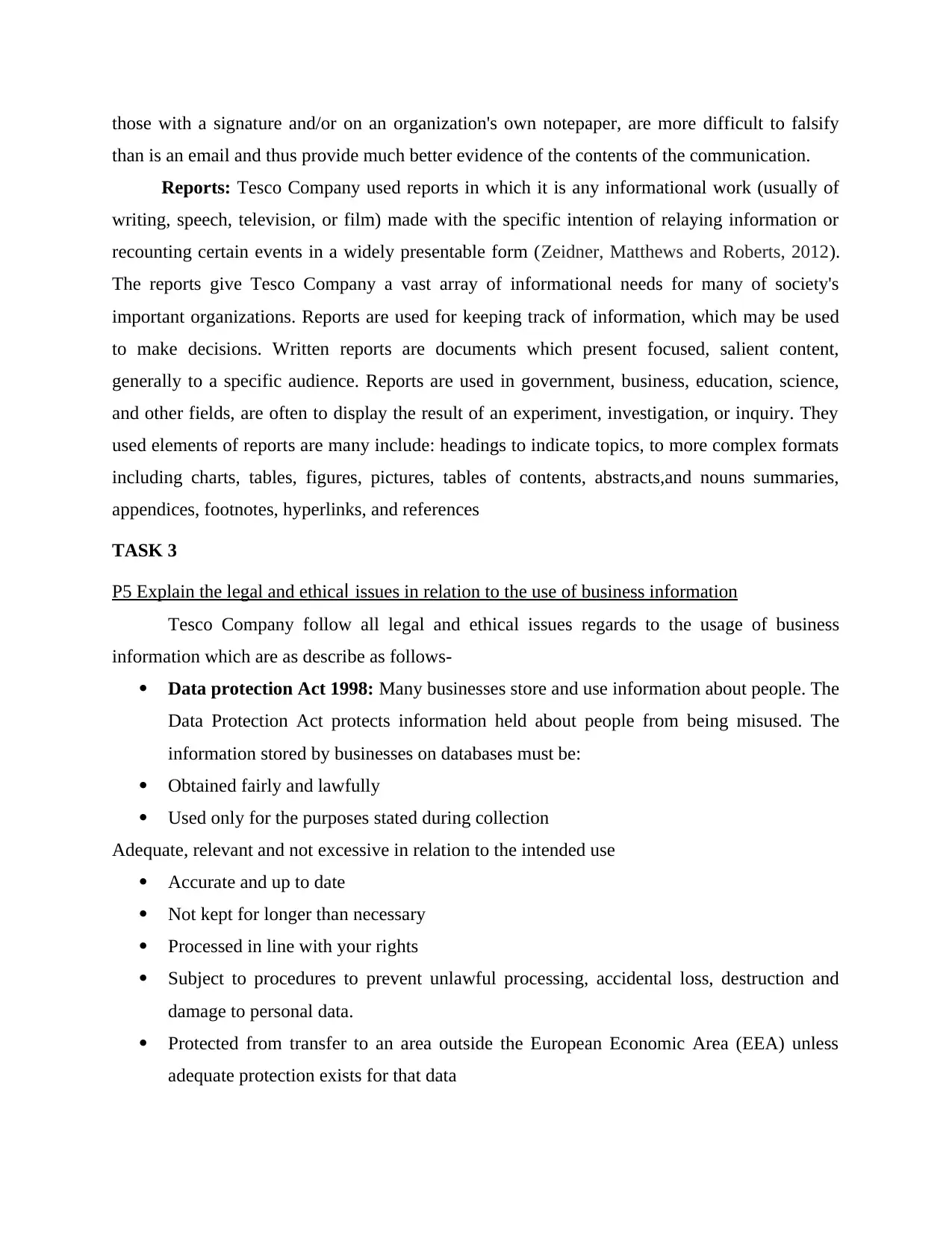
those with a signature and/or on an organization's own notepaper, are more difficult to falsify
than is an email and thus provide much better evidence of the contents of the communication.
Reports: Tesco Company used reports in which it is any informational work (usually of
writing, speech, television, or film) made with the specific intention of relaying information or
recounting certain events in a widely presentable form (Zeidner, Matthews and Roberts, 2012).
The reports give Tesco Company a vast array of informational needs for many of society's
important organizations. Reports are used for keeping track of information, which may be used
to make decisions. Written reports are documents which present focused, salient content,
generally to a specific audience. Reports are used in government, business, education, science,
and other fields, are often to display the result of an experiment, investigation, or inquiry. They
used elements of reports are many include: headings to indicate topics, to more complex formats
including charts, tables, figures, pictures, tables of contents, abstracts,and nouns summaries,
appendices, footnotes, hyperlinks, and references
TASK 3
P5 Explain the legal and ethical issues in relation to the use of business information
Tesco Company follow all legal and ethical issues regards to the usage of business
information which are as describe as follows-
Data protection Act 1998: Many businesses store and use information about people. The
Data Protection Act protects information held about people from being misused. The
information stored by businesses on databases must be:
Obtained fairly and lawfully
Used only for the purposes stated during collection
Adequate, relevant and not excessive in relation to the intended use
Accurate and up to date
Not kept for longer than necessary
Processed in line with your rights
Subject to procedures to prevent unlawful processing, accidental loss, destruction and
damage to personal data.
Protected from transfer to an area outside the European Economic Area (EEA) unless
adequate protection exists for that data
than is an email and thus provide much better evidence of the contents of the communication.
Reports: Tesco Company used reports in which it is any informational work (usually of
writing, speech, television, or film) made with the specific intention of relaying information or
recounting certain events in a widely presentable form (Zeidner, Matthews and Roberts, 2012).
The reports give Tesco Company a vast array of informational needs for many of society's
important organizations. Reports are used for keeping track of information, which may be used
to make decisions. Written reports are documents which present focused, salient content,
generally to a specific audience. Reports are used in government, business, education, science,
and other fields, are often to display the result of an experiment, investigation, or inquiry. They
used elements of reports are many include: headings to indicate topics, to more complex formats
including charts, tables, figures, pictures, tables of contents, abstracts,and nouns summaries,
appendices, footnotes, hyperlinks, and references
TASK 3
P5 Explain the legal and ethical issues in relation to the use of business information
Tesco Company follow all legal and ethical issues regards to the usage of business
information which are as describe as follows-
Data protection Act 1998: Many businesses store and use information about people. The
Data Protection Act protects information held about people from being misused. The
information stored by businesses on databases must be:
Obtained fairly and lawfully
Used only for the purposes stated during collection
Adequate, relevant and not excessive in relation to the intended use
Accurate and up to date
Not kept for longer than necessary
Processed in line with your rights
Subject to procedures to prevent unlawful processing, accidental loss, destruction and
damage to personal data.
Protected from transfer to an area outside the European Economic Area (EEA) unless
adequate protection exists for that data
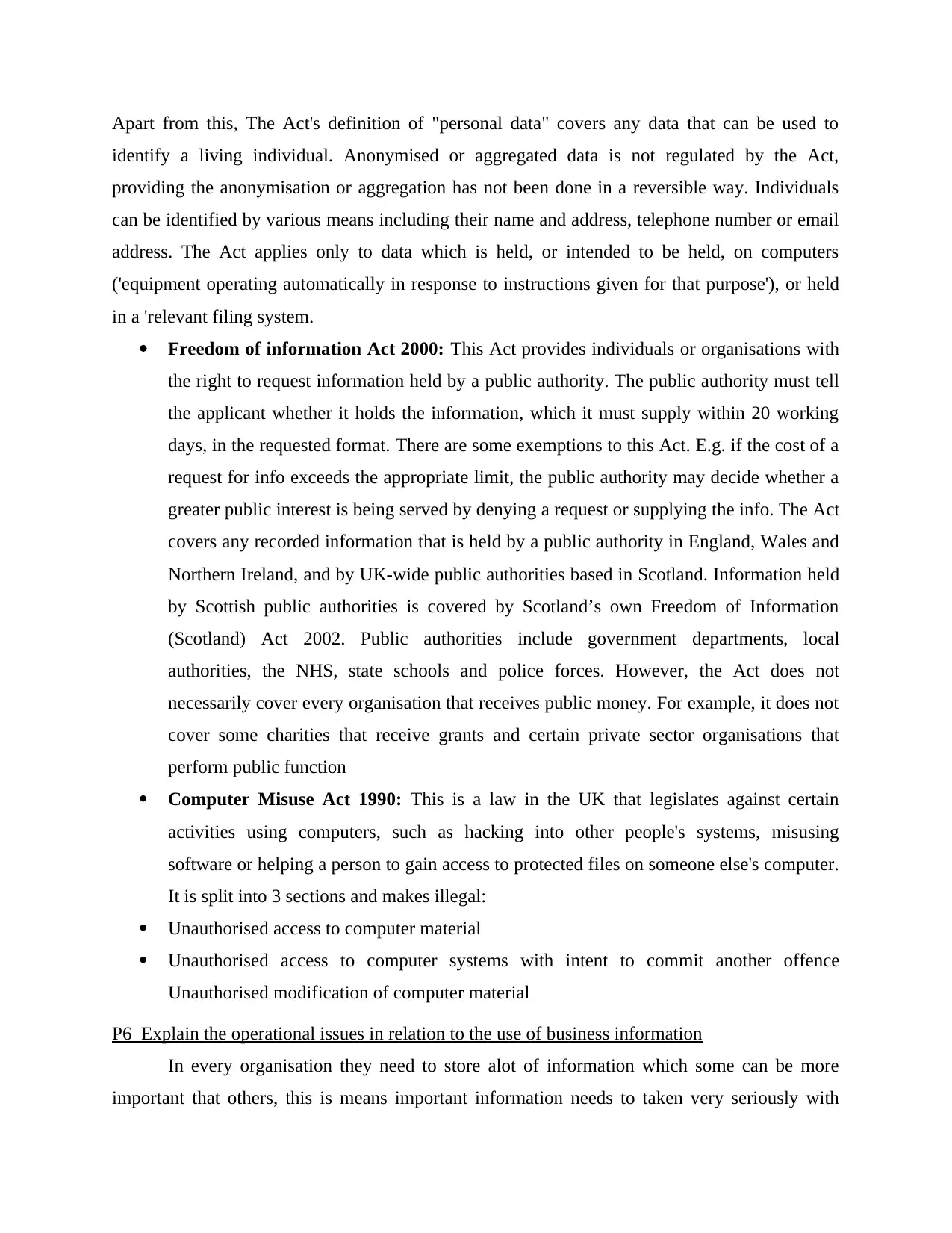
Apart from this, The Act's definition of "personal data" covers any data that can be used to
identify a living individual. Anonymised or aggregated data is not regulated by the Act,
providing the anonymisation or aggregation has not been done in a reversible way. Individuals
can be identified by various means including their name and address, telephone number or email
address. The Act applies only to data which is held, or intended to be held, on computers
('equipment operating automatically in response to instructions given for that purpose'), or held
in a 'relevant filing system.
Freedom of information Act 2000: This Act provides individuals or organisations with
the right to request information held by a public authority. The public authority must tell
the applicant whether it holds the information, which it must supply within 20 working
days, in the requested format. There are some exemptions to this Act. E.g. if the cost of a
request for info exceeds the appropriate limit, the public authority may decide whether a
greater public interest is being served by denying a request or supplying the info. The Act
covers any recorded information that is held by a public authority in England, Wales and
Northern Ireland, and by UK-wide public authorities based in Scotland. Information held
by Scottish public authorities is covered by Scotland’s own Freedom of Information
(Scotland) Act 2002. Public authorities include government departments, local
authorities, the NHS, state schools and police forces. However, the Act does not
necessarily cover every organisation that receives public money. For example, it does not
cover some charities that receive grants and certain private sector organisations that
perform public function
Computer Misuse Act 1990: This is a law in the UK that legislates against certain
activities using computers, such as hacking into other people's systems, misusing
software or helping a person to gain access to protected files on someone else's computer.
It is split into 3 sections and makes illegal:
Unauthorised access to computer material
Unauthorised access to computer systems with intent to commit another offence
Unauthorised modification of computer material
P6 Explain the operational issues in relation to the use of business information
In every organisation they need to store alot of information which some can be more
important that others, this is means important information needs to taken very seriously with
identify a living individual. Anonymised or aggregated data is not regulated by the Act,
providing the anonymisation or aggregation has not been done in a reversible way. Individuals
can be identified by various means including their name and address, telephone number or email
address. The Act applies only to data which is held, or intended to be held, on computers
('equipment operating automatically in response to instructions given for that purpose'), or held
in a 'relevant filing system.
Freedom of information Act 2000: This Act provides individuals or organisations with
the right to request information held by a public authority. The public authority must tell
the applicant whether it holds the information, which it must supply within 20 working
days, in the requested format. There are some exemptions to this Act. E.g. if the cost of a
request for info exceeds the appropriate limit, the public authority may decide whether a
greater public interest is being served by denying a request or supplying the info. The Act
covers any recorded information that is held by a public authority in England, Wales and
Northern Ireland, and by UK-wide public authorities based in Scotland. Information held
by Scottish public authorities is covered by Scotland’s own Freedom of Information
(Scotland) Act 2002. Public authorities include government departments, local
authorities, the NHS, state schools and police forces. However, the Act does not
necessarily cover every organisation that receives public money. For example, it does not
cover some charities that receive grants and certain private sector organisations that
perform public function
Computer Misuse Act 1990: This is a law in the UK that legislates against certain
activities using computers, such as hacking into other people's systems, misusing
software or helping a person to gain access to protected files on someone else's computer.
It is split into 3 sections and makes illegal:
Unauthorised access to computer material
Unauthorised access to computer systems with intent to commit another offence
Unauthorised modification of computer material
P6 Explain the operational issues in relation to the use of business information
In every organisation they need to store alot of information which some can be more
important that others, this is means important information needs to taken very seriously with
⊘ This is a preview!⊘
Do you want full access?
Subscribe today to unlock all pages.

Trusted by 1+ million students worldwide
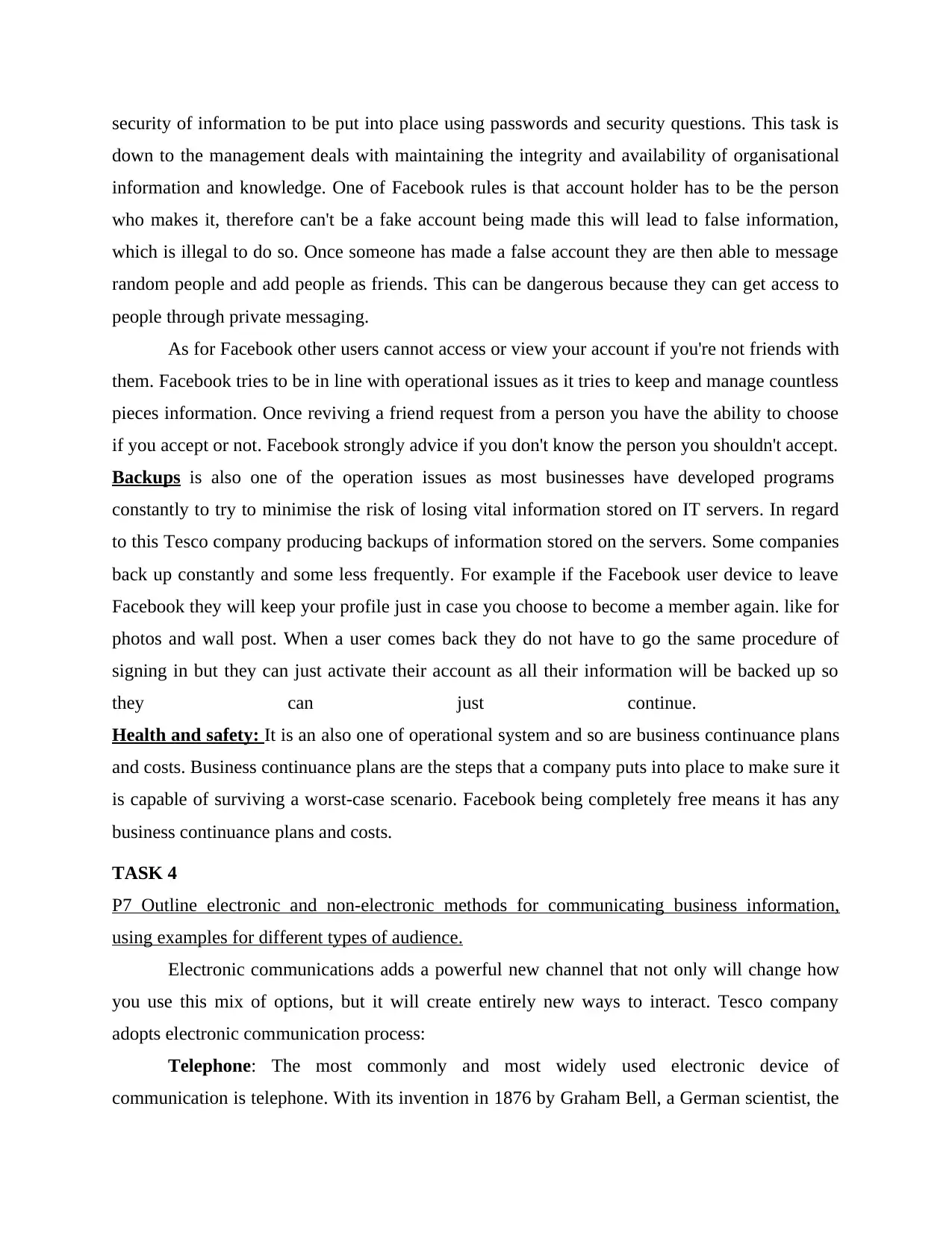
security of information to be put into place using passwords and security questions. This task is
down to the management deals with maintaining the integrity and availability of organisational
information and knowledge. One of Facebook rules is that account holder has to be the person
who makes it, therefore can't be a fake account being made this will lead to false information,
which is illegal to do so. Once someone has made a false account they are then able to message
random people and add people as friends. This can be dangerous because they can get access to
people through private messaging.
As for Facebook other users cannot access or view your account if you're not friends with
them. Facebook tries to be in line with operational issues as it tries to keep and manage countless
pieces information. Once reviving a friend request from a person you have the ability to choose
if you accept or not. Facebook strongly advice if you don't know the person you shouldn't accept.
Backups is also one of the operation issues as most businesses have developed programs
constantly to try to minimise the risk of losing vital information stored on IT servers. In regard
to this Tesco company producing backups of information stored on the servers. Some companies
back up constantly and some less frequently. For example if the Facebook user device to leave
Facebook they will keep your profile just in case you choose to become a member again. like for
photos and wall post. When a user comes back they do not have to go the same procedure of
signing in but they can just activate their account as all their information will be backed up so
they can just continue.
Health and safety: It is an also one of operational system and so are business continuance plans
and costs. Business continuance plans are the steps that a company puts into place to make sure it
is capable of surviving a worst-case scenario. Facebook being completely free means it has any
business continuance plans and costs.
TASK 4
P7 Outline electronic and non-electronic methods for communicating business information,
using examples for different types of audience.
Electronic communications adds a powerful new channel that not only will change how
you use this mix of options, but it will create entirely new ways to interact. Tesco company
adopts electronic communication process:
Telephone: The most commonly and most widely used electronic device of
communication is telephone. With its invention in 1876 by Graham Bell, a German scientist, the
down to the management deals with maintaining the integrity and availability of organisational
information and knowledge. One of Facebook rules is that account holder has to be the person
who makes it, therefore can't be a fake account being made this will lead to false information,
which is illegal to do so. Once someone has made a false account they are then able to message
random people and add people as friends. This can be dangerous because they can get access to
people through private messaging.
As for Facebook other users cannot access or view your account if you're not friends with
them. Facebook tries to be in line with operational issues as it tries to keep and manage countless
pieces information. Once reviving a friend request from a person you have the ability to choose
if you accept or not. Facebook strongly advice if you don't know the person you shouldn't accept.
Backups is also one of the operation issues as most businesses have developed programs
constantly to try to minimise the risk of losing vital information stored on IT servers. In regard
to this Tesco company producing backups of information stored on the servers. Some companies
back up constantly and some less frequently. For example if the Facebook user device to leave
Facebook they will keep your profile just in case you choose to become a member again. like for
photos and wall post. When a user comes back they do not have to go the same procedure of
signing in but they can just activate their account as all their information will be backed up so
they can just continue.
Health and safety: It is an also one of operational system and so are business continuance plans
and costs. Business continuance plans are the steps that a company puts into place to make sure it
is capable of surviving a worst-case scenario. Facebook being completely free means it has any
business continuance plans and costs.
TASK 4
P7 Outline electronic and non-electronic methods for communicating business information,
using examples for different types of audience.
Electronic communications adds a powerful new channel that not only will change how
you use this mix of options, but it will create entirely new ways to interact. Tesco company
adopts electronic communication process:
Telephone: The most commonly and most widely used electronic device of
communication is telephone. With its invention in 1876 by Graham Bell, a German scientist, the
Paraphrase This Document
Need a fresh take? Get an instant paraphrase of this document with our AI Paraphraser
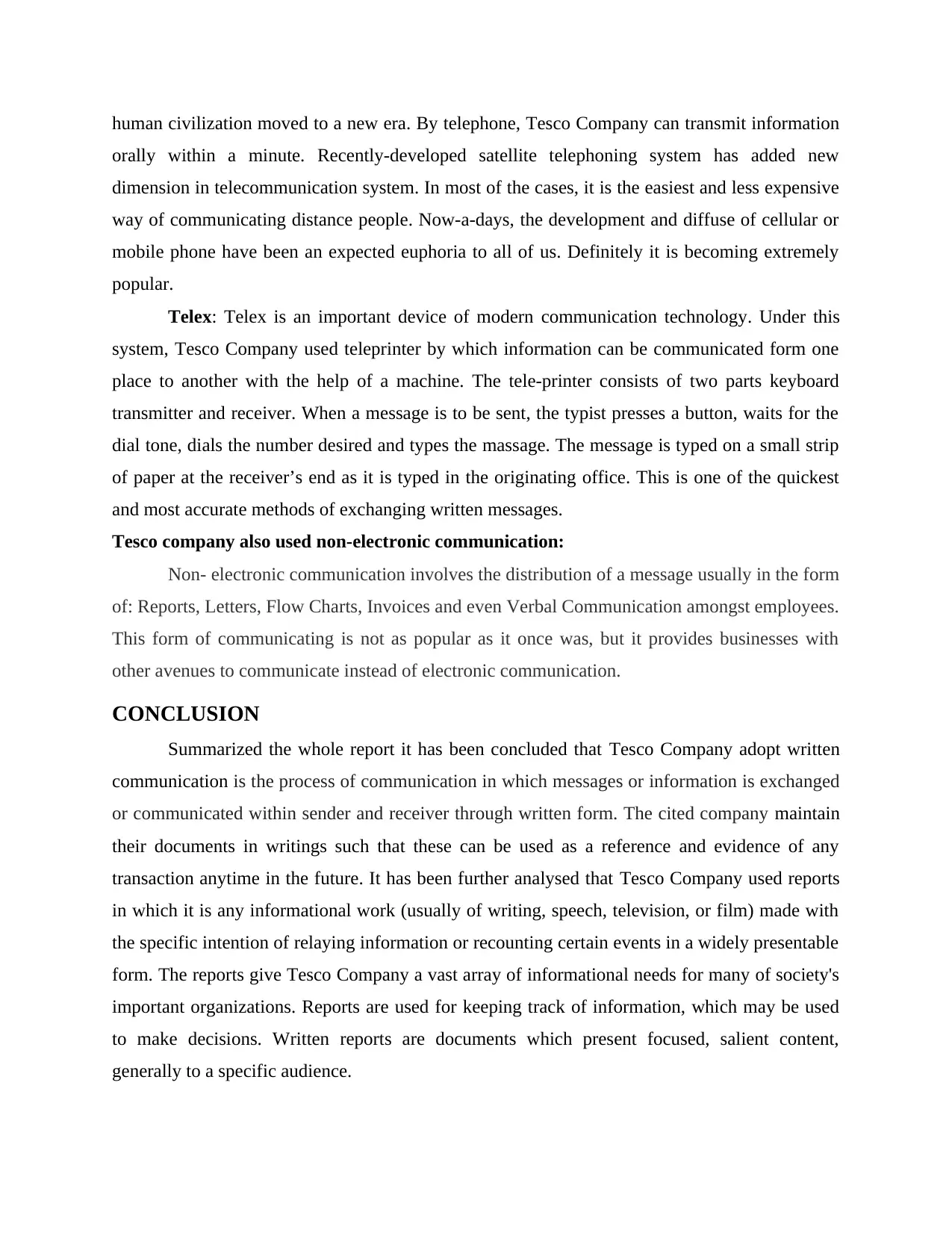
human civilization moved to a new era. By telephone, Tesco Company can transmit information
orally within a minute. Recently-developed satellite telephoning system has added new
dimension in telecommunication system. In most of the cases, it is the easiest and less expensive
way of communicating distance people. Now-a-days, the development and diffuse of cellular or
mobile phone have been an expected euphoria to all of us. Definitely it is becoming extremely
popular.
Telex: Telex is an important device of modern communication technology. Under this
system, Tesco Company used teleprinter by which information can be communicated form one
place to another with the help of a machine. The tele-printer consists of two parts keyboard
transmitter and receiver. When a message is to be sent, the typist presses a button, waits for the
dial tone, dials the number desired and types the massage. The message is typed on a small strip
of paper at the receiver’s end as it is typed in the originating office. This is one of the quickest
and most accurate methods of exchanging written messages.
Tesco company also used non-electronic communication:
Non- electronic communication involves the distribution of a message usually in the form
of: Reports, Letters, Flow Charts, Invoices and even Verbal Communication amongst employees.
This form of communicating is not as popular as it once was, but it provides businesses with
other avenues to communicate instead of electronic communication.
CONCLUSION
Summarized the whole report it has been concluded that Tesco Company adopt written
communication is the process of communication in which messages or information is exchanged
or communicated within sender and receiver through written form. The cited company maintain
their documents in writings such that these can be used as a reference and evidence of any
transaction anytime in the future. It has been further analysed that Tesco Company used reports
in which it is any informational work (usually of writing, speech, television, or film) made with
the specific intention of relaying information or recounting certain events in a widely presentable
form. The reports give Tesco Company a vast array of informational needs for many of society's
important organizations. Reports are used for keeping track of information, which may be used
to make decisions. Written reports are documents which present focused, salient content,
generally to a specific audience.
orally within a minute. Recently-developed satellite telephoning system has added new
dimension in telecommunication system. In most of the cases, it is the easiest and less expensive
way of communicating distance people. Now-a-days, the development and diffuse of cellular or
mobile phone have been an expected euphoria to all of us. Definitely it is becoming extremely
popular.
Telex: Telex is an important device of modern communication technology. Under this
system, Tesco Company used teleprinter by which information can be communicated form one
place to another with the help of a machine. The tele-printer consists of two parts keyboard
transmitter and receiver. When a message is to be sent, the typist presses a button, waits for the
dial tone, dials the number desired and types the massage. The message is typed on a small strip
of paper at the receiver’s end as it is typed in the originating office. This is one of the quickest
and most accurate methods of exchanging written messages.
Tesco company also used non-electronic communication:
Non- electronic communication involves the distribution of a message usually in the form
of: Reports, Letters, Flow Charts, Invoices and even Verbal Communication amongst employees.
This form of communicating is not as popular as it once was, but it provides businesses with
other avenues to communicate instead of electronic communication.
CONCLUSION
Summarized the whole report it has been concluded that Tesco Company adopt written
communication is the process of communication in which messages or information is exchanged
or communicated within sender and receiver through written form. The cited company maintain
their documents in writings such that these can be used as a reference and evidence of any
transaction anytime in the future. It has been further analysed that Tesco Company used reports
in which it is any informational work (usually of writing, speech, television, or film) made with
the specific intention of relaying information or recounting certain events in a widely presentable
form. The reports give Tesco Company a vast array of informational needs for many of society's
important organizations. Reports are used for keeping track of information, which may be used
to make decisions. Written reports are documents which present focused, salient content,
generally to a specific audience.
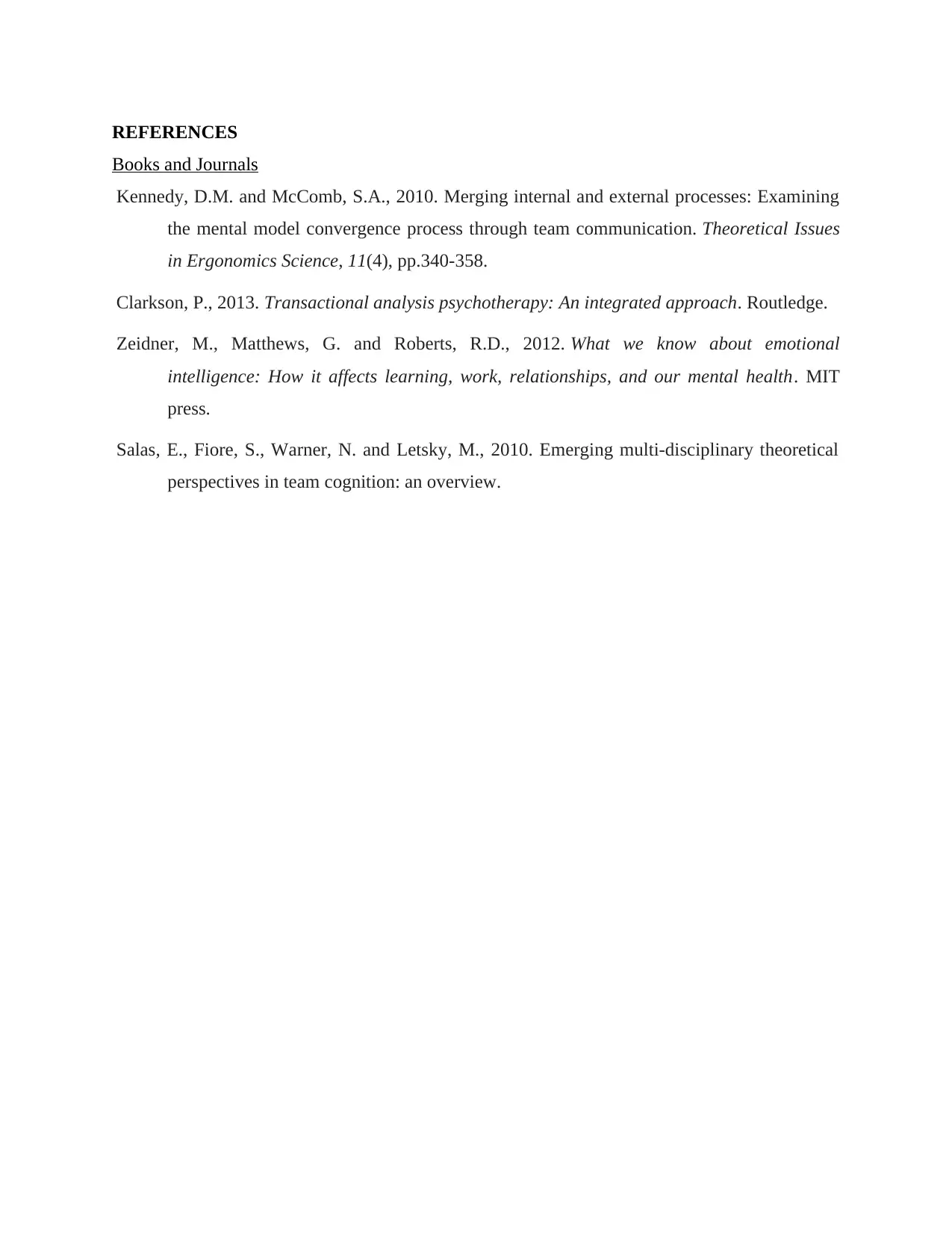
REFERENCES
Books and Journals
Kennedy, D.M. and McComb, S.A., 2010. Merging internal and external processes: Examining
the mental model convergence process through team communication. Theoretical Issues
in Ergonomics Science, 11(4), pp.340-358.
Clarkson, P., 2013. Transactional analysis psychotherapy: An integrated approach. Routledge.
Zeidner, M., Matthews, G. and Roberts, R.D., 2012. What we know about emotional
intelligence: How it affects learning, work, relationships, and our mental health. MIT
press.
Salas, E., Fiore, S., Warner, N. and Letsky, M., 2010. Emerging multi-disciplinary theoretical
perspectives in team cognition: an overview.
Books and Journals
Kennedy, D.M. and McComb, S.A., 2010. Merging internal and external processes: Examining
the mental model convergence process through team communication. Theoretical Issues
in Ergonomics Science, 11(4), pp.340-358.
Clarkson, P., 2013. Transactional analysis psychotherapy: An integrated approach. Routledge.
Zeidner, M., Matthews, G. and Roberts, R.D., 2012. What we know about emotional
intelligence: How it affects learning, work, relationships, and our mental health. MIT
press.
Salas, E., Fiore, S., Warner, N. and Letsky, M., 2010. Emerging multi-disciplinary theoretical
perspectives in team cognition: an overview.
⊘ This is a preview!⊘
Do you want full access?
Subscribe today to unlock all pages.

Trusted by 1+ million students worldwide
1 out of 12
Related Documents
Your All-in-One AI-Powered Toolkit for Academic Success.
+13062052269
info@desklib.com
Available 24*7 on WhatsApp / Email
![[object Object]](/_next/static/media/star-bottom.7253800d.svg)
Unlock your academic potential
Copyright © 2020–2025 A2Z Services. All Rights Reserved. Developed and managed by ZUCOL.





